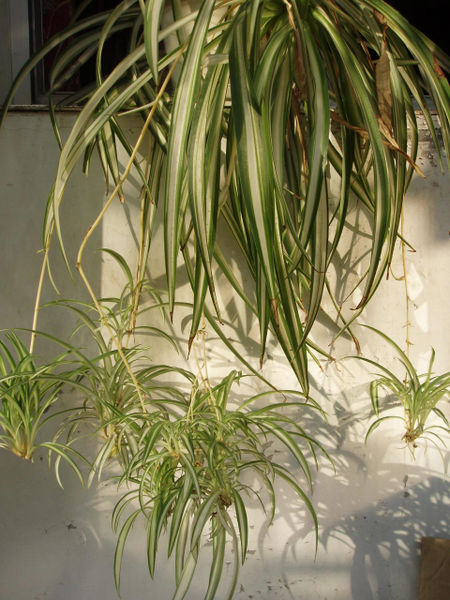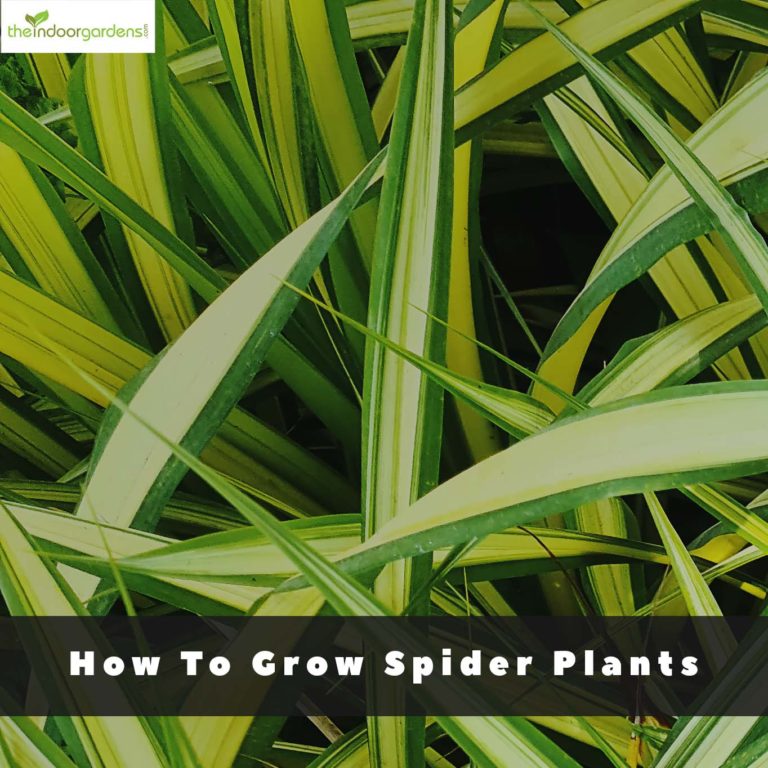Don’t let the name freak you out, spider plants aren’t scary at all. They are actually a great choice to add some greenery to your home and come with very basic care needs. With a bit of water and sunlight, a well-taken-care of spider plant can live for well over 50 years! Spider plants are a great choice for those looking for a good-looking but low-maintenance houseplant.
Spider Plant Quick Overview
- Spider plants are very easy to grow, and great choices for beginners looking to get started in gardening.
- They like indirect light and do well in some shade. Avoid direct sunlight and too much shade for optimal growth.
- Water when the soil is dry, usually 1-2 times per week. You can also fertilize once per month in the summer.
- Spider plants are easy to propagate and can be done either through division or by planting the shoots it puts off.
- The most common issue is browning leaf tips. This is caused by either too much sun, minerals in tap water, or over-fertilizing.
Soil and Container
Spider plants can be grown in traditional containers, but also do well in hanging ones. In either case, look to get one slightly larger than the root ball of your current plant. Spider plants like to be slightly root-bound, so it’s best to use a slightly smaller container and repot often. We’ll look a bit more at repotting below.
For soil, look for well-draining, general-purpose potting soil. The majority of potting soil you can find at any hardware store or nursery should suffice.
Lastly, an important part of spider plant care is repotting. Spider plant’s roots grow very quickly, and when left alone they will eventually crack through their container. Either that, or they’ll become a twisted mess that will literally choke off your plant.
That’s why it’s important to periodically re-pot. Once you see the roots poking through the top of the soil it’s time to move to a new pot a few inches larger. How often you do this depends on how fast the plant grows which depends on care so it will be different for everyone. Expect to have to do so a few times over the plant’s lifetime, generally more often for younger plants.
Planting Your Spider Plant
Spider plants are a very common houseplant, so will be available at most nurseries or online. When starting with a seedling, all you all have to do is move it to its permanent home. Gently remove it from its store-bought container to avoid damaging the roots. Then give it a healthy dose of water.
You can also choose to start from seed. Sow your seeds about ½ inch deep into high-quality soil and keep the soil warm and moist. It can take a few weeks for germination so don’t be concerned if it seems to be taking longer than other seeds. It’s best to use seeds freshly harvested from an adult spider plant as they don’t store very well.
Once the seedling shows 6+ true leaves you can transplant it. This is a bit longer than other plants as spider plants dislike being transplanted too soon. It’s best to wait an extra week or two before moving to their true home than to transplant too soon. The stress can kill the plant if done too early.
Lighting
Spider plants enjoy lots of indirect light. They don’t need to be sitting in full sun all day but should be in a sunny location that is indirectly lit. Outdoors, this would be called partial shade.
A foot or two back from a large window is a good spot that will provide them with enough light. Spider plants are fairly hardy though, so they will grow in lower light and shady conditions as well. In these cases, expect them to grow a bit more slowly, and consider giving them a brighter location in winter when the sunlight is less intense. You can utilize grow lights if needed, but in most cases, this will be unnecessary.
Watering And Feeding
Spider plants like to be watered thoroughly and then left alone to dry out. You don’t want them sitting in soggy soil as that can kill the plant.
Wait until the top inch of the soil is completely dried out before watering until the soil is saturated. Wait until you see water begin to leak from the drainage holes. For younger plants watering about once a week is around the average. Older plants will need water even less, and every other week isn’t uncommon.
For feeding, look to do so roughly once per month in the summer growing season. You can cut back to less during the winter when the plant’s growth will slow in cooler climates. Use a water-soluable fertilizer, and look to dilute it to about half strength. You can also utilize slow-release fertilizers which can provide nutrients for longer.
One last thing you might notice is the browning of the tips of the leaves. This can be caused by too intense direct sunlight but is more often caused by minerals that are found in most tap waters. If you notice this happening you can switch to purified water, or simply leave tap water out overnight. This will help remove some of the minerals that can build up in the soil. It can also be caused by too much fertilizer, but this is usually the least likely culprit
Design Tips
Spider plants are a popular aspect of minimalist and modern design due to their sophisticated look. As their flowers are small this plant is often grown for its green-stripped foliage. They go great in hanging baskets but also look fantastic on top of columns or similar raised areas. Look to really accentuate their trailling leaves for the most dramatic effect.
Temperature and Humidity
Spider plants don’t like cold temperatures and should be kept in an area above 60°F. They should also be grown away from drafty areas or in direct line of air conditioning units.
Spider plants also like a slightly humid environment. The best way to do this is to lightly mist it every other day. This not only helps keep humidity in check, but also helps keep the plant hydrated between waterings.

Tip
You can move your spider plant outdoors in the warmer months for extra sun. Make sure to bring them indoors as the temperature drops and avoid exposing it to any frost.
Pruning and Propagation
Spider plants don’t need frequent pruning, and when doing so it should generally be limited to dead or dying parts of the plant. You might also small shoots coming off the plant. These can be clipped off to help direct energy toward the main plant. This is often only needed if you’re noticing leggy growth.

These shoots can also be clipped off to propagate new plants. Wait until they have roots about an inch long, then snip them off and plant them in their own container. As an example, in the above image you can see multiple shoots off the parent plant that are ready to snip. You can also take a division directly from the main plant. Spider plants are one of the easiest plants to propagate, so it’s a great plant to start with.
How To Care For a Spider Plant
Spider plant care is relatively simple and the plants themselves are quite hardy; these combined make spider plants very popular for anyone looking to add greenery to their home. Spider plants are perfect for first-time growers, all the way up to experts, and are a beautiful addition to any home.
Spider Plant FAQ
How Do You Repot a Spider Plant?
Simply dig up the plant (gently!), lightly wash and trim the roots, then place it into its new container and cover the roots with soil. Look to move to a container only a few inches bigger than the previous as spider plants grow best when container bound.
Why are The Tips of My Spider Plant Browning?
This can be caused by too intense sunlight, but often is the result of minerals present in tap water. When watering, use purified water, or leave tap water out overnight to remove some of these minerals naturally.
How Long Do Spider Plants Live For?
Well taken care of a spider plant can live 50+ years. Many families pass them down generations as the plant can often outlive its owner.
Do Spider Plants Flower?
Spider plants do have flowers; they will produce small white ones towards the ends of their leaves. Many people don't even notice these flowers as they are small and blend in with the plant's foliage.







